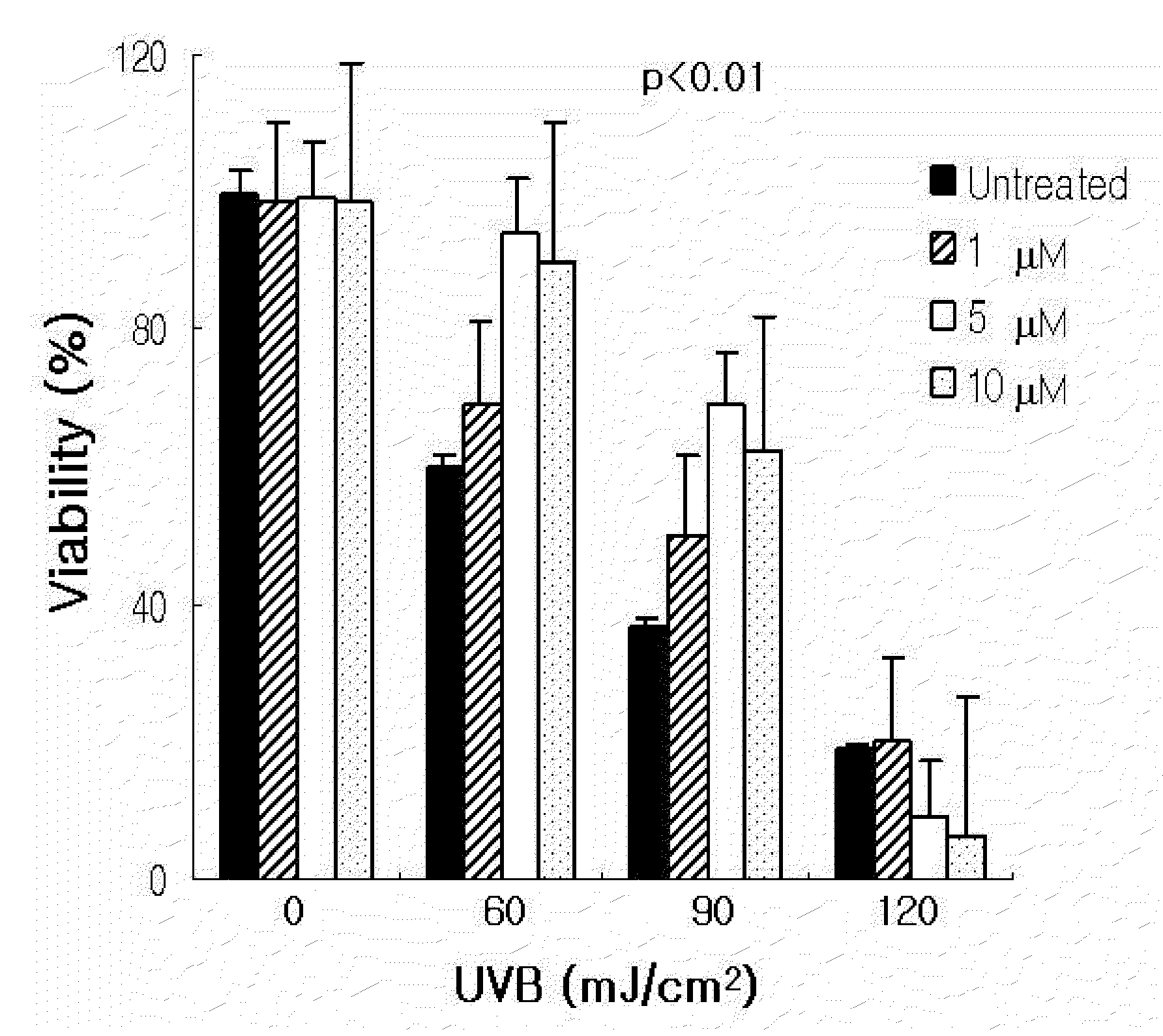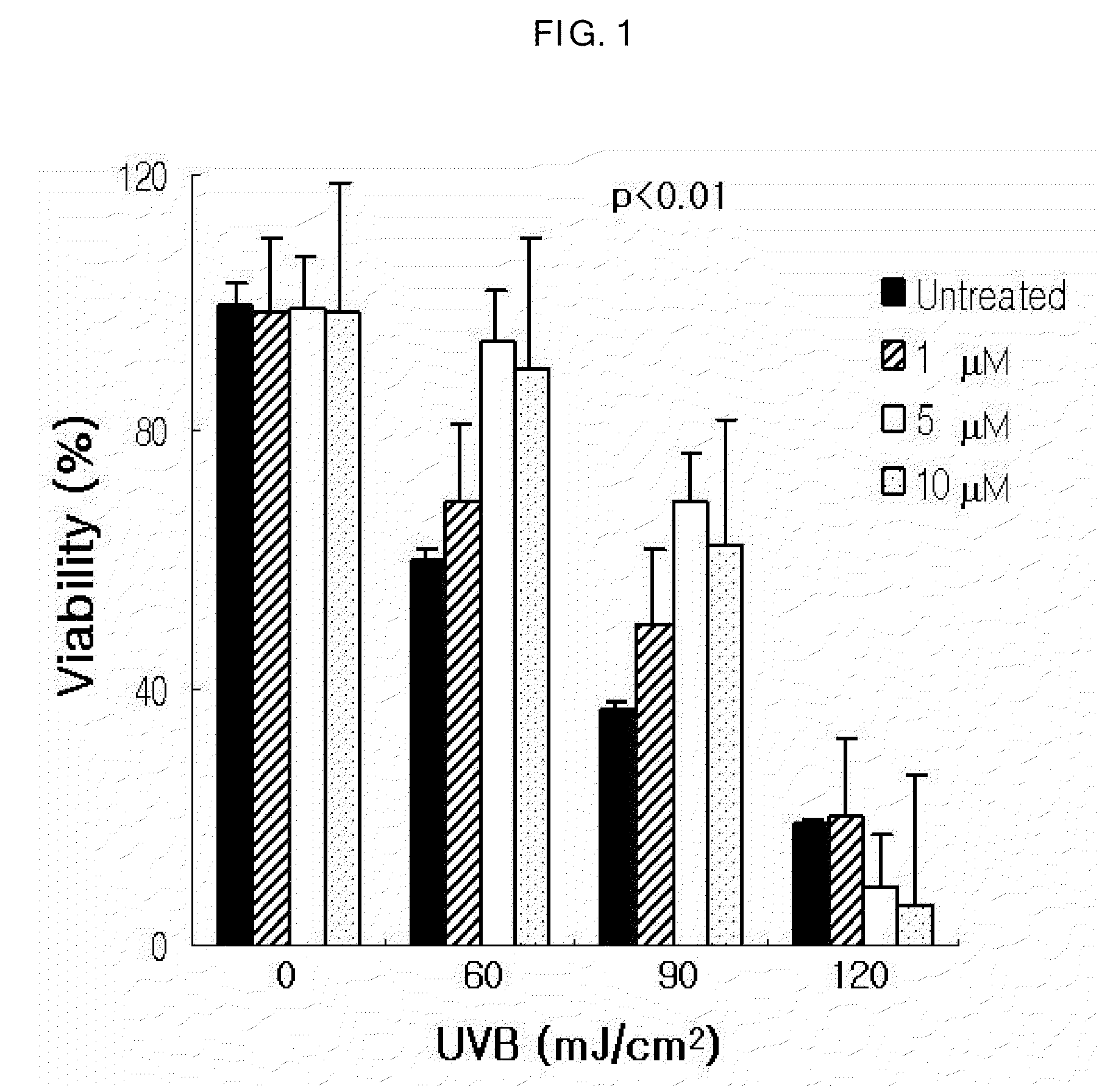AGENT FOR CONTROLLING Bcl-2 EXPRESSION COMPRISING GINSENOSIDE F1 AS AN ACTIVE COMPONENT
a technology of ginsenoside and bcl-2, which is applied in the direction of anti-noxious agents, drug compositions, biocides, etc., can solve the problems of generating sunburn cells, mechanisms or factors to control the expression of bcl-2 in hacat cells derived from human skin, and have not yet been disclosed. to achieve the effect of inhibiting the downregulation of bcl-2, promoting bcl-2 expression, and reducing bcl-2
- Summary
- Abstract
- Description
- Claims
- Application Information
AI Technical Summary
Benefits of technology
Problems solved by technology
Method used
Image
Examples
reference example 1
Preparation of Purified Ginseng Saponin
[0023]2 kg of Red ginseng (KT&G Corporation, 6 year old red ginseng) was added into 4 l of methanol containing water, and refluxed 3 times then deposited for 6 days at 15° C. Residues and remainders were separated by filtration and centrifugation, then the remainders were concentrated under reduced pressure to obtain extract. The extract was suspended into the water and re-extracted with 1 l of ether 5 times to remove pigments, then water layer thereof was extracted with 500 ml of 1-butanol 3 times. The above-obtained 1-butanol layer was treated with 5% of KOH and washed with distilled water then concentrated under reduced pressure to obtain 1-butanol extract. The extract (1-butanol extract) was dissolved in a small amount of methanol, and a large amount of ethylacetate was added thereto to obtain precipitation. The precipitation was dried to obtain 70 g of purified ginseng saponin extract.
reference example 2
Preparation of Gensenoside F1
[0024]10 g of purified ginseng saponin obtained from the Reference Example 1 was dissolved in 1000 ml of citrate buffer solution (pH 4.0), 15 g of naringinase obtained from penicillium sp. was added thereto and reacted for 48 hours while stirring at 40° C. After the reaction, reaction mixture was heated for 10 minutes to inactivate the enzyme, then the reaction mixture was extracted 3 times with same amount of ethylacetae and concentrated. The product obtained underwent column chromatography (chloroform:methanol=9:1) and finally separated 1.5 g of ginsenoside F1.
example 1
Inhibition of Apoptosis of HaCaT Cells Induced by Ultraviolet Radiation, when Treated with Ginsenoside F1
[0025]Human keratinocyte, HaCaT (obtained from Dr. Fusenig in German Cancer Research Center (DKFZ)) was cultured in Dulbecco's modified Eagle's Medium (DMEM; Gibco 1210-0038) containing 10% of fetal bovin serum at 37° C. and 5% of CO2.
Inhibition of Apoptosis of Cells Induced by Ultraviolet Radiation, when Treated with Ginsenoside F1
[0026]Cells cultured in step 1 were treated with trypsin to obtain single cell suspension, and seeded into 6-well flask with 2×105 / well, then cultured for 24 hours. After that, the cells were cultured again in a new DMEM not containing fetal bovin serum for 24 hours, then treated with 1, 5, 10 μM of ginsenoside F1. Ginsenoside F1 was dissolved in 100% ethanol and added to be 1 / 1000 of the medium concentration. After 24 hours of treatment with ginsenoside F1, the cell cultures were washed with phosphate buffered saline (PBS),...
PUM
| Property | Measurement | Unit |
|---|---|---|
| wavelength | aaaaa | aaaaa |
| wavelength | aaaaa | aaaaa |
| pH | aaaaa | aaaaa |
Abstract
Description
Claims
Application Information
 Login to View More
Login to View More - R&D
- Intellectual Property
- Life Sciences
- Materials
- Tech Scout
- Unparalleled Data Quality
- Higher Quality Content
- 60% Fewer Hallucinations
Browse by: Latest US Patents, China's latest patents, Technical Efficacy Thesaurus, Application Domain, Technology Topic, Popular Technical Reports.
© 2025 PatSnap. All rights reserved.Legal|Privacy policy|Modern Slavery Act Transparency Statement|Sitemap|About US| Contact US: help@patsnap.com



